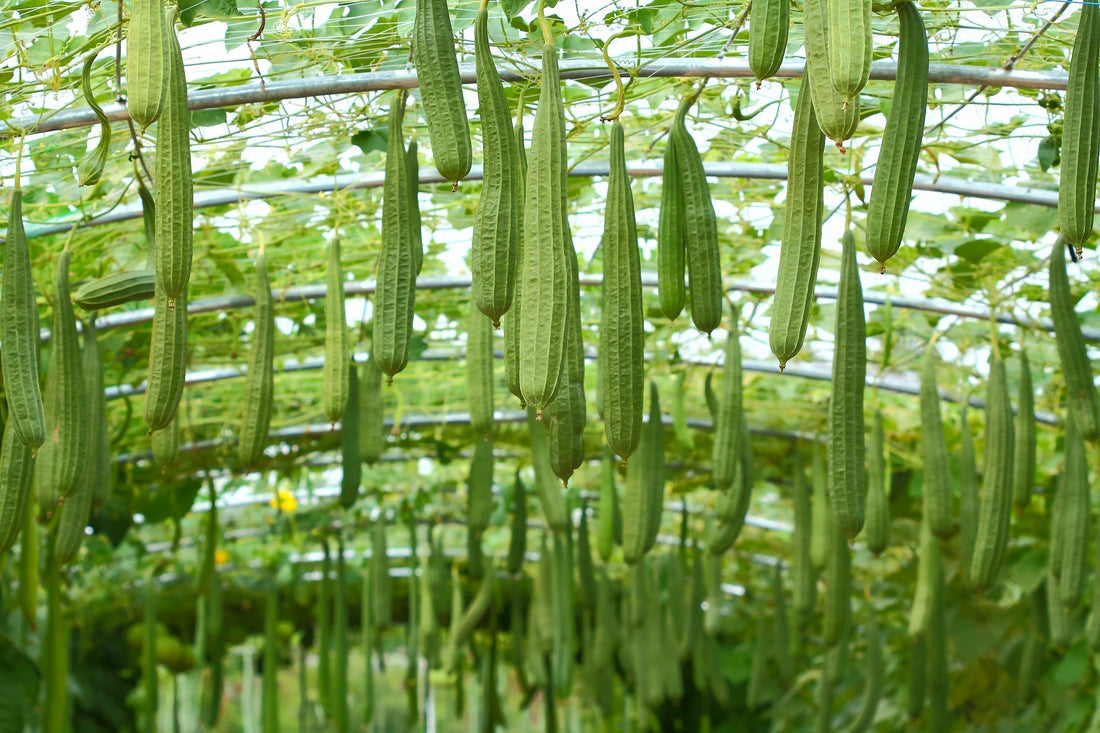
Grow Ridge Gourd in Pakistan: Moji Mall Guide
Share
Ridge gourd (توری) is a fast-growing summer vegetable that thrives in Pakistan’s climate. With enough sunlight, space, and regular care, it produces tender fruits perfect for everyday meals. Here’s an easy guide to grow ridge gourd successfully at home.
| Aspect | Details |
|---|---|
| Best Sowing Time | February to May |
| Ideal Temperature | 24°C to 32°C |
| Germination Time | 5–10 days |
| Transplant Time | 2–3 weeks after sowing |
| Spacing | 2–3 feet between plants |
| Harvest Time | 50–70 days after sowing |
Step 1: Sow Seeds 🌱
When to Sow:
- Sow seeds from February to May, when the weather is warm and stable.
- Ideal soil temperature for sowing is 24°C to 32°C.
- Avoid cold, wet conditions.
How to Sow: Soak seeds overnight before sowing. Direct sow seeds 1 inch deep in soft, compost-rich soil. Sow 2–3 seeds per spot.
Germination Tips: Seeds usually sprout in 5–10 days. Keep the soil moist but not soggy during germination.
Step 2: Transplant Seedlings 🌿
When to Transplant: If starting in trays, transplant when seedlings have 2–3 true leaves, about 2–3 weeks after sowing.
How to Transplant: Space plants 2–3 feet apart in beds or large pots (at least 14–16 inches wide) and provide trellis support early.
Aftercare: Water well after transplanting. Support vines with strings, nets, or bamboo sticks.
Step 3: Care for Plants 🌞💧
Sunlight Needs: Ridge gourd needs 6–8 hours of full sun daily for vigorous growth and fruiting.
Watering: Water 2–3 times a week, keeping soil consistently moist. Avoid waterlogging.
Feeding Schedule: Mix compost into soil before sowing. Feed with NPK 20-20-20 every 15 days after transplanting, then switch to NPK 5-15-45 during flowering.
Step 4: Protect Plants 🐛
Common Pests: Look out for fruit flies, aphids, red beetles, and fungal issues like powdery mildew.
Natural Protection: Spray neem oil every 10–12 days (1 teaspoon neem oil + 1 liter water + few drops soap), especially under leaves and around flowers.
Common Problems:
- Poor Fruit Set: May be due to low pollination — hand-pollinate if bees are few.
- Rotting Fruits: Happens when fruits touch wet soil — train vines upward and mulch.
- Yellow Leaves: Usually from nutrient deficiency or irregular watering.
Step 5: Harvest Gourds 🥒
When to Harvest: Ridge gourd is ready 50–70 days after sowing, when fruits are 6–10 inches long, bright green, and still tender.
How to Harvest: Cut fruits with a knife or scissors every 2–3 days to keep vines producing.
Bonus Tip: Young gourds taste best — don’t let them overgrow or they turn fibrous.
FAQs
Can I grow ridge gourd in pots?
Yes, use large pots (14–16 inches wide) and provide a sturdy trellis or allow vines to trail.
How long do ridge gourd vines grow?
Vines can reach 10–15 feet or more, so plan for space or vertical support.
Why are my ridge gourds bitter or hard?
Usually due to harvesting late — always pick when fruits are young and tender.
Why are my ridge gourds not forming?
Poor pollination is often the cause. Try hand-pollinating flowers early in the morning.
Can I eat ridge gourd leaves?
Yes, young leaves and tips are edible and commonly used in stir-fries in many cuisines.
Ridge gourd grows quickly and is easy to manage if you give it sun, water, and support. With just a little attention, you’ll enjoy a regular harvest of fresh, healthy tori — a great addition to summer meals.

